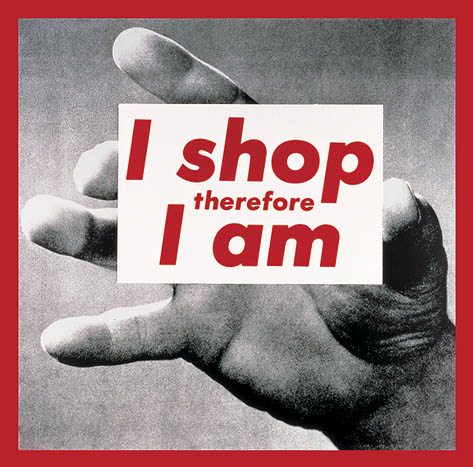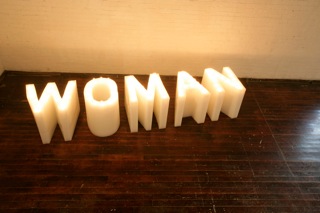Exploring
the female identity is not contained to one culture, class, religion or
generation. These female artists have explored their place in society as well
as the art world through various techniques. Mixed media, painting and
photography serve as the platform for which they explore gendered
identity. Each woman’s work is a unique expression
of her anguish, rage, joy, confusion, etc. at her own interpretation of the female
identity, her identity, and societal constructs of it.
Georgia O’Keefe (b.1887) is best known as the female painter at the forefront of modernism. Her work spans over 70 years, having her first solo exhibition at Gallery 291 in 1917. She was inspired to delve into abstraction after reading Kandinsky’s On the Spiritual in Art. Although her work never reached full abstraction she played with the flatness of the canvas and the precision of forms. This can be seen in works ranging from Calla Lilies, 1923 to Radiator Building, 1927.
 |
| courtesy of bandagear.com |
Georgia O’Keefe (b.1887) is best known as the female painter at the forefront of modernism. Her work spans over 70 years, having her first solo exhibition at Gallery 291 in 1917. She was inspired to delve into abstraction after reading Kandinsky’s On the Spiritual in Art. Although her work never reached full abstraction she played with the flatness of the canvas and the precision of forms. This can be seen in works ranging from Calla Lilies, 1923 to Radiator Building, 1927.
O’Keefe
is also identified by her association with a man and what his images of her
impressed on people. Alfred Steiglitz, her partner, took over 300 portrait and
nude images of her over two decades. These images degraded O’Keeffe to an
object, a muse, and just a woman. Her work was constantly scrutinized and
compared to the male artist, Hartley stated there was a “feminine perception and
feminine powers of expression” (Chadwick, 306), making her not an artist first
and foremost but a female first and artist second. O’Keefe’s paintings were
often ‘read’ into because of her gender and the ideological constructions of a
woman, turning a flower into a vulva and a building into a penis.
Barbara
Kruger (b 1945) uses graphics and mass media to comment on issues of female
identity. Kruger appropriates images, often of female archetypes, placing text
on top of the image to comment on the female identity through a masculine lens.
The text is confrontational and ironic, speaking in the voice of the woman with
the male gaze upon her. This commentary can be seen in Untitled (Your gaze…) 1981.
Drawing
from her private experiences and viewpoints Kruger creates statement pieces for
the female collective. “Making art is about objectifying your experience of the
world, transforming the flow of movements into something visual, or textual or
musical. Art creates a kind of commentary.”(Taschen, 187) Pieces like Untitled (I shop therefore I am) point out our dependence on consumer
culture.” For some people, shopping has turned into a lifestyle consuming at
our leisure. Some feel that, the power of consumption is stopping us from
finding true and sincere happiness…” (West 2010)
 |
| Kruger, Untitled (I shop therefore I am) 1987 |
Anita
Dube (b 1958) uses many mediums to address the female identity. Drawing for her
formal education as an art historian and critic her pieces are conceptual and
fluid. Her piece Woman , 2007,is made of paraffin wax and wicks. She created
the word “woman” out of the wax and let it burn throughout the show, constantly
being effected by the environment. One article states “The notion of womanhood
as a candle that is gradually extinguishing its own existence through the act
of burning is a powerful one to digest.” (D’Mello)
 |
| Dube Woman , 2007 |
Dube has also created an alter identity to address
her own issues of gender within her Indian culture. Noor, her alter ego, is man
and through him she is free to articulate problematic “performative gestures in
culture as well as activism-Anita Dube” (Sternberger, pg. 97) she records him as
part of her video installation. It portrays the nine ‘rasas’ ( ‘sentiments’ in Indian
aesthetics, the characteristic qualities of literature, drama and music) Throughout
the video Noor transforms from friendly to aggressive and open minded to
tradition. As a female artists in India she is hyper aware of societal constructs
and Noor enables her freedom to speak.
Currently on exhibit at the
Brooklyn Museum is Wangechi Mutu (b 1972), whom through mixed media addresses the
identity of the black female body. She specifically explores the eroticization
of the black female body through the figures she creates. The figures are
fantastical but recognizable. They are both sharp and soft in depicting the
female body using a variety of tools from plastic pearls and ink to paint and felt
she creates collages and installations that speak to her heritage as a woman, a
Kenyan and a citizen of the world.
Her large scale females as seen in The Bride Who Married a Camel’s Head 2009and
People in Glass Towers Should Not Imagine
Us 2003 are otherworldly and distinctive. They both contain animal prints
in them, possibly a reference to her African heritage, and beautiful feminine
curves, indicative of the typically thought of black female body. But both
females are semi naked and postured in aggressive manners. These stances could be
seen as an association of black females as an “other”.
Tejal Shah addresses the female
identity through queer framework. Shah uses photography, performance and media
in her work to address issues of desire, transgender, fantasy,religion and
politics. As an Indian artist she uses her culture prominently in her pieces. In
Southern Siren - Maheshwari, 2006
Shah portrays Maheshwari who is male by birth but identifies with the female
gender identity. She places him in a romantic bollywoodesque dance sequence,
combining popular culture and the female lead. Shah’s work addresses what makes
a woman a woman? Is it more than just having a vagina?
 |
| Maheshwari, 2006 courtesy of Brooklynmuseum.org |
These five women are all artists
that have and are pushing the boundaries on gender identification. From O’Keefe trying to be more than just a
muse and seen through the lens of being a female to Shah questioning the essence
of identifying as a female, each woman has made a contribution in breaking
boundaries. The female gender identity is not only a woman’s issue it is a man’s
issue and spans across cultures, age, class and race.
http://artworld101.independentplymouth.info/barbara-kruger/
http://www.cornerhouse.org/film/cinema-listings/indian-video-art-between-myth-and-history
http://www.naturemorte.com/artists/anita-dube/artist-cv/
Artwork
of
the
Week:
“Woman,”
Anita
Dube by Rosalyn D'Mello ‘Blouin Artinfo’ Published: June
16, 2013
Chadwick, Whitney. Women, Art, and
Society. London: Thames & Hudson, 2002. Print.
Grosenick, Uta, and Ilka Becker.
Women Artists in the 20th and 21st Century. Köln: Taschen, 2005. Print.
Sinha, Gayatri, Brian Drolet,
Barbara London, Suketu Mehta, and Paul Spencer. Sternberger. India: Public
Places, Private Spaces. Newark N.J: Newark Museum, 2007. Print.

No comments:
Post a Comment